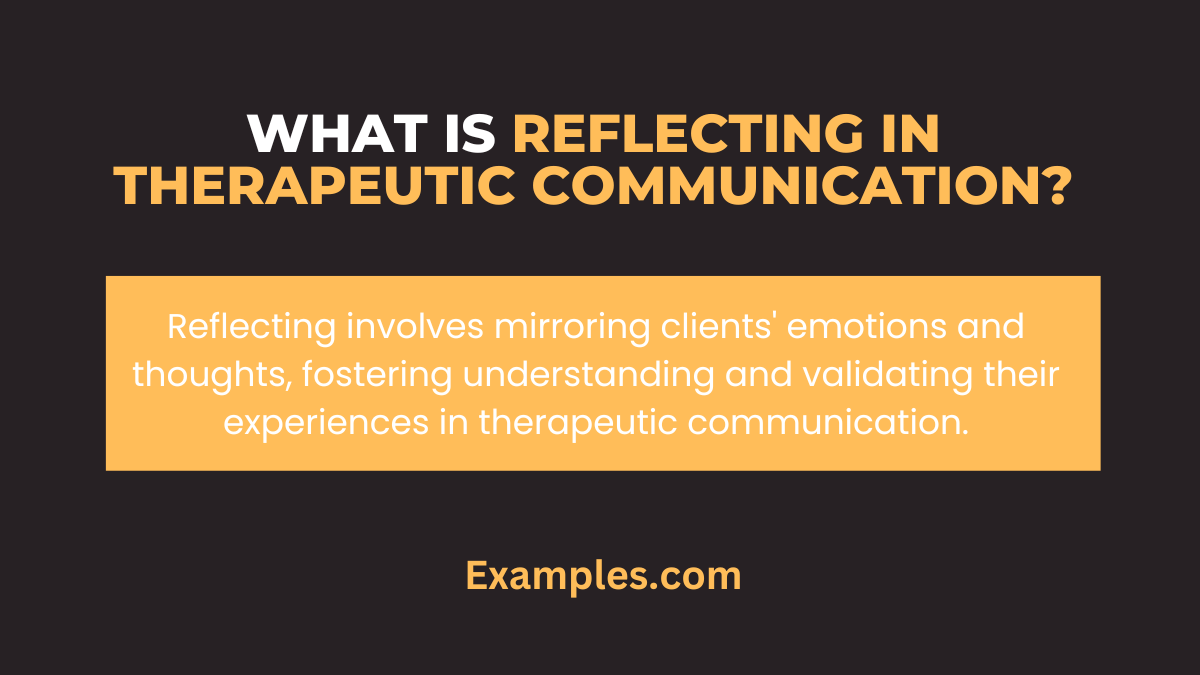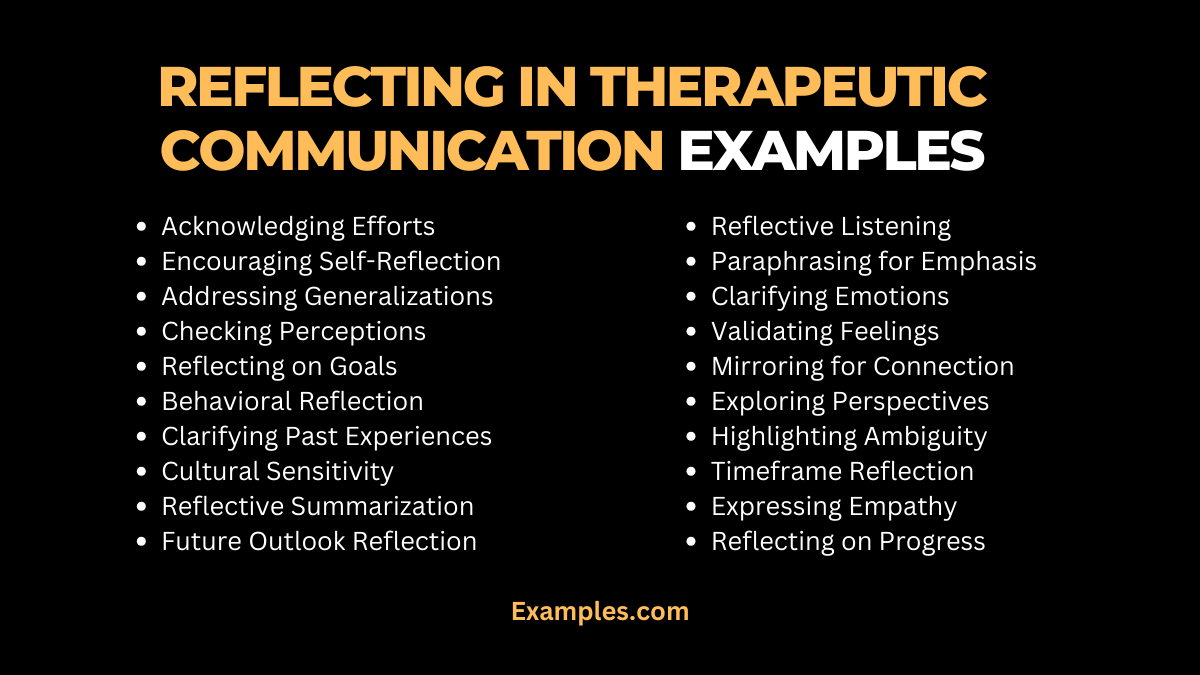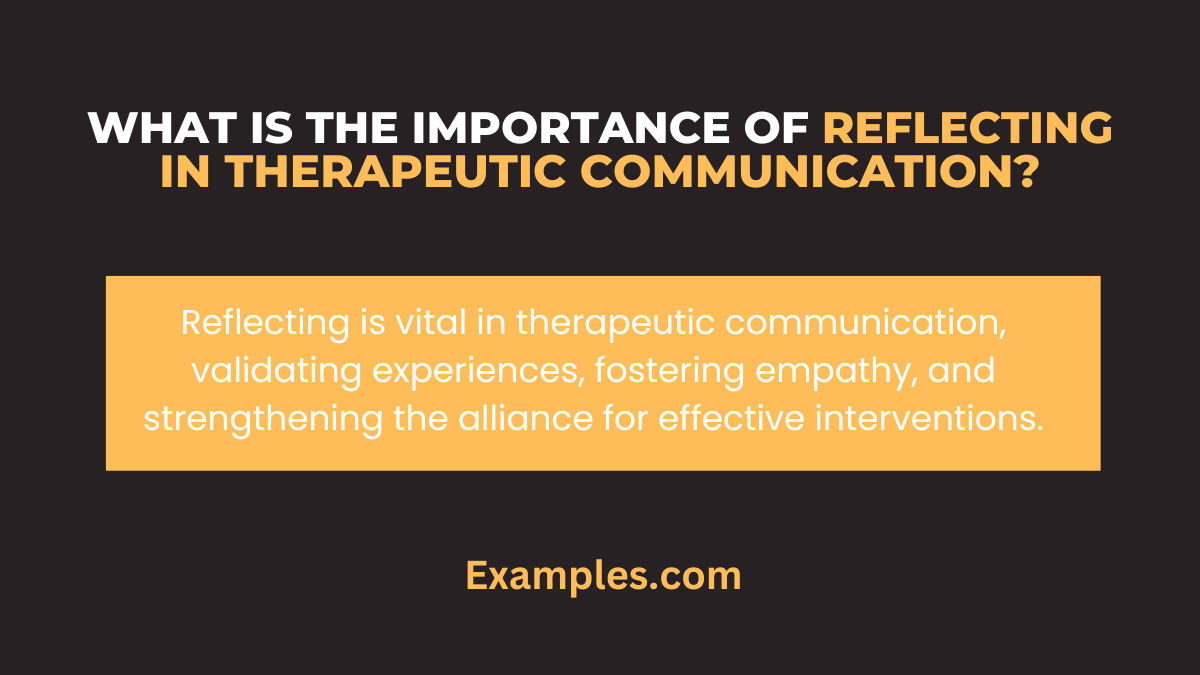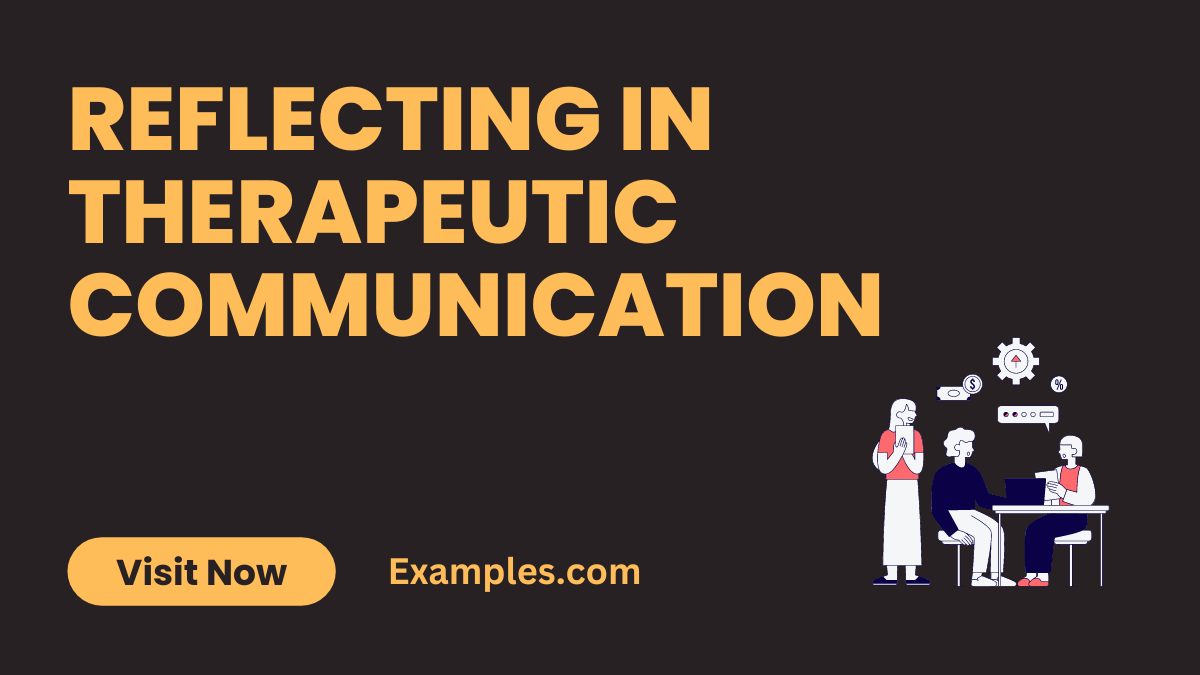19+ Reflecting in Therapeutic Communication Examples
Embark on a transformative journey into the world of therapeutic communication as we present a complete guide on Reflecting. This comprehensive resource unfolds the art of reflective practice, providing impactful examples that empower practitioners to enhance their communication skills. Dive into the nuanced techniques of reflection, fostering deep connections and enriching therapeutic dialogues. Explore the vast landscape of communication examples that illuminate the path to mastering this essential skill in therapeutic interactions.
What is Reflecting in Therapeutic Communication?

Reflecting in therapeutic communication involves the practitioner mirroring or summarizing the client’s expressed feelings or thoughts. This technique aims to convey understanding, validate emotions, and encourage clients to delve deeper into their experiences. By reflecting, practitioners create a safe and empathetic space, fostering a stronger therapeutic alliance and facilitating clients’ exploration of their feelings and concerns.
20 Reflecting in Therapeutic Communication Examples

Unlock the power of reflective practice with these 20 illuminating examples in therapeutic communication. Dive into nuanced techniques that amplify empathy and deepen connections, fostering a transformative dialogue between practitioners and clients.
- Reflective Listening: “I hear you’re feeling overwhelmed. Can you share more about what’s contributing to this overwhelm?”
- Paraphrasing for Emphasis: “If I understand correctly, the stress at work is impacting your well-being. Can you elaborate further?”
- Clarifying Emotions: “It seems like you’re expressing frustration about the situation. Can you tell me more about it?”
- Validating Feelings: “It’s okay to feel anxious before the appointment. Can you help me understand your concerns?”
- Mirroring for Connection: “I sense you’re feeling distant in the relationship. Can you elaborate on what might be causing this distance?”
- Exploring Perspectives: “When you mention ‘struggling,’ are these challenges more personal or work-related?”
- Highlighting Ambiguity: “You’ve mentioned feeling ‘lost.’ Can you clarify what aspects make you feel uncertain or directionless?”
- Timeframe Reflection: “When you say ‘recently,’ are you referring to the past few days or weeks?”
- Expressing Empathy: “I can imagine that receiving that news was quite shocking. How are you processing it?”
- Reflecting on Progress: “You’ve mentioned ‘improvement.’ Can you elaborate on the positive changes you’re noticing?”
- Acknowledging Efforts: “It sounds like you’ve been working hard on this. What specific steps have you taken?”
- Encouraging Self-Reflection: “Your mention of ‘mixed feelings’ is interesting. Can we explore those emotions more deeply?”
- Addressing Generalizations: “When you say ‘always,’ can you provide specific instances where this has occurred?”
- Checking Perceptions: “Is my understanding accurate, or is there a different angle you’d like me to consider?”
- Reflecting on Goals: “When you mention ‘progress,’ what specific goals are you aiming for in our sessions?”
- Behavioral Reflection: “You mentioned ‘withdrawal.’ Can you describe specific behaviors associated with this withdrawal?”
- Clarifying Past Experiences: “Your reference to ‘similar situations’ is intriguing. Can you recall specific instances for comparison?”
- Cultural Sensitivity: “Considering cultural nuances, how does this situation align with your cultural background?”
- Reflective Summarization: “Reflecting on our conversation, can we summarize the key points you’ve shared so far?”
- Future Outlook Reflection: “I’m interpreting your words as a desire for change. Can you visualize how this change might unfold?”
Reflecting in Therapeutic Communication Examples for Students
Empower students with the art of reflection in therapeutic communication. These examples showcase the transformative impact of reflective techniques in fostering understanding and emotional intelligence among students.
- Personal Growth Reflection: “Reflect on your personal growth journey. Can you identify specific milestones that have shaped you?”
- Academic Stress Acknowledgment: “I sense academic stress. Can you reflect on strategies that might ease this pressure?”
- Interpersonal Dynamics: “Reflect on recent interactions. How can understanding others’ perspectives enhance your relationships?”
- Goal Setting Reflection: “You’ve mentioned goals. Can you reflect on how these align with your long-term aspirations?”
- Exploring Values: “Reflect on your values. How do they influence your decision-making and interactions with others?”
- Balancing Priorities: “I sense conflicting priorities. Can you reflect on strategies for maintaining a healthy balance?”
- Addressing Challenges: “Reflect on challenges faced. What resilience strategies have you developed in response?”
- Emotional Resonance: “Reflect on emotions experienced. How might understanding these emotions contribute to personal growth?”
- Learning Styles Reflection: “Consider your learning style. How can adapting it enhance your academic experience?”
- Peer Relationships Reflection: “Reflect on peer interactions. How might empathy deepen connections with classmates?”
Reflecting in Therapeutic Communication Examples in Healthcare
Explore reflective techniques in healthcare settings, where practitioners use empathy to understand patients’ experiences deeply. These examples illustrate how reflection enhances communication, fostering patient trust and promoting holistic well-being.
- Pain Management Reflection: “Reflect on your pain experiences. How can this reflection guide personalized pain management strategies?”
- Treatment Decision Reflection: “Consider treatment decisions. How might reflecting on values aid in making informed choices?”
- End-of-Life Care Reflection: “Reflect on end-of-life preferences. How can this reflection guide compassionate care decisions?”
- Patient-Provider Communication: “Reflect on recent interactions. How might understanding patient perspectives enhance communication?”
- Cultural Competence Reflection: “Reflect on cultural awareness. How can this reflection guide culturally sensitive healthcare practices?”
- Patient Education Reflection: “Reflect on patient education approaches. How might adapting strategies enhance understanding?”
- Compassion Fatigue Reflection: “Reflect on emotional fatigue. How can self-reflection contribute to emotional well-being in healthcare?”
- Improving Patient Experience: “Reflect on patient feedback. How might reflection guide improvements for a positive healthcare experience?”
- Collaborative Care Reflection: “Reflect on collaborative care. How can this reflection strengthen interdisciplinary healthcare teamwork?”
- Addressing Patient Concerns: “Reflect on patient concerns. How might reflective listening enhance understanding and address anxieties?”
What are Techniques of Reflecting in Therapeutic Communication?
In mastering the art of reflecting, practitioners employ various techniques to deepen understanding and foster empathy. Techniques include paraphrasing, summarizing, mirroring emotions, and asking open-ended questions. By echoing clients’ thoughts and emotions, practitioners create a reflective dialogue, enhancing the therapeutic alliance.
What is the Importance of Reflecting in Therapeutic Communication?

Reflecting holds immense significance in therapeutic communication. It validates clients’ experiences, communicates empathy, and fosters a safe space for self-exploration. By mirroring emotions and thoughts, practitioners build trust, strengthen the therapeutic alliance, and contribute to clients’ overall well-being. Reflection enhances communication, promoting a deeper understanding of clients’ concerns and facilitating more effective interventions.
How Reflecting in Therapeutic Communications Helpful for Patients?
Reflecting in therapeutic communication is beneficial for patients in various ways, contributing to their overall well-being and the effectiveness of the therapeutic process. Here are key points highlighting its advantages:
- Enhanced Self-Awareness: Reflecting allows patients to hear and see their thoughts and feelings mirrored by the therapist, promoting self-awareness and insight.
- Validation of Emotions: It validates patients’ emotions by confirming that their experiences and feelings are acknowledged and understood.
- Clarification of Thoughts: The reflective process provides an opportunity for patients to clarify and organize their thoughts, fostering a clearer understanding of their own narratives.
- Empathetic Connection: Reflective listening establishes a strong empathetic connection, demonstrating that the therapist is attuned and engaged in the patient’s unique experiences.
- Encourages Open Expression: Patients often feel more comfortable and encouraged to express themselves openly when they sense that their therapist is actively reflecting on their words.
- Building Trust: Reflecting demonstrates the therapist’s commitment to understanding the patient’s perspective, contributing to the establishment of trust in the therapeutic relationship.
- Facilitates Emotional Exploration: Patients may explore deeper emotions and experiences when they sense a reflective and non-judgmental environment, promoting emotional exploration.
- Promotes Effective Communication: It enhances the overall quality of communication between the therapist and patient, ensuring that messages are accurately received and interpreted.
- Problem Solving: Reflection assists in problem-solving by providing patients with a clearer view of their challenges and helping them consider potential solutions.
- Supports Emotional Processing: Reflecting aids in the processing of complex or distressing emotions, contributing to emotional regulation and coping strategies.
In conclusion, mastering the art of reflecting in therapeutic communication is paramount for building meaningful connections. This comprehensive guide has illuminated the techniques, importance, and effective tips, offering a roadmap to enhance communication skills. Through powerful examples, practitioners can now navigate reflective practice with precision, fostering a therapeutic alliance that nurtures healing and positive client outcomes.
19+ Reflecting in Therapeutic Communication Examples

Embark on a transformative journey into the world of therapeutic communication as we present a complete guide on Reflecting. This comprehensive resource unfolds the art of reflective practice, providing impactful examples that empower practitioners to enhance their communication skills. Dive into the nuanced techniques of reflection, fostering deep connections and enriching therapeutic dialogues. Explore the vast landscape of communication examples that illuminate the path to mastering this essential skill in therapeutic interactions.
What is Reflecting in Therapeutic Communication?

Reflecting in therapeutic communication involves the practitioner mirroring or summarizing the client’s expressed feelings or thoughts. This technique aims to convey understanding, validate emotions, and encourage clients to delve deeper into their experiences. By reflecting, practitioners create a safe and empathetic space, fostering a stronger therapeutic alliance and facilitating clients’ exploration of their feelings and concerns.
20 Reflecting in Therapeutic Communication Examples

Unlock the power of reflective practice with these 20 illuminating examples in therapeutic communication. Dive into nuanced techniques that amplify empathy and deepen connections, fostering a transformative dialogue between practitioners and clients.
Reflective Listening: “I hear you’re feeling overwhelmed. Can you share more about what’s contributing to this overwhelm?”
Paraphrasing for Emphasis: “If I understand correctly, the stress at work is impacting your well-being. Can you elaborate further?”
Clarifying Emotions: “It seems like you’re expressing frustration about the situation. Can you tell me more about it?”
Validating Feelings: “It’s okay to feel anxious before the appointment. Can you help me understand your concerns?”
Mirroring for Connection: “I sense you’re feeling distant in the relationship. Can you elaborate on what might be causing this distance?”
Exploring Perspectives: “When you mention ‘struggling,’ are these challenges more personal or work-related?”
Highlighting Ambiguity: “You’ve mentioned feeling ‘lost.’ Can you clarify what aspects make you feel uncertain or directionless?”
Timeframe Reflection: “When you say ‘recently,’ are you referring to the past few days or weeks?”
Expressing Empathy: “I can imagine that receiving that news was quite shocking. How are you processing it?”
Reflecting on Progress: “You’ve mentioned ‘improvement.’ Can you elaborate on the positive changes you’re noticing?”
Acknowledging Efforts: “It sounds like you’ve been working hard on this. What specific steps have you taken?”
Encouraging Self-Reflection: “Your mention of ‘mixed feelings’ is interesting. Can we explore those emotions more deeply?”
Addressing Generalizations: “When you say ‘always,’ can you provide specific instances where this has occurred?”
Checking Perceptions: “Is my understanding accurate, or is there a different angle you’d like me to consider?”
Reflecting on Goals: “When you mention ‘progress,’ what specific goals are you aiming for in our sessions?”
Behavioral Reflection: “You mentioned ‘withdrawal.’ Can you describe specific behaviors associated with this withdrawal?”
Clarifying Past Experiences: “Your reference to ‘similar situations’ is intriguing. Can you recall specific instances for comparison?”
Cultural Sensitivity: “Considering cultural nuances, how does this situation align with your cultural background?”
Reflective Summarization: “Reflecting on our conversation, can we summarize the key points you’ve shared so far?”
Future Outlook Reflection: “I’m interpreting your words as a desire for change. Can you visualize how this change might unfold?”
Reflecting in Therapeutic Communication Examples for Students
Empower students with the art of reflection in therapeutic communication. These examples showcase the transformative impact of reflective techniques in fostering understanding and emotional intelligence among students.
Personal Growth Reflection: “Reflect on your personal growth journey. Can you identify specific milestones that have shaped you?”
Academic Stress Acknowledgment: “I sense academic stress. Can you reflect on strategies that might ease this pressure?”
Interpersonal Dynamics: “Reflect on recent interactions. How can understanding others’ perspectives enhance your relationships?”
Goal Setting Reflection: “You’ve mentioned goals. Can you reflect on how these align with your long-term aspirations?”
Exploring Values: “Reflect on your values. How do they influence your decision-making and interactions with others?”
Balancing Priorities: “I sense conflicting priorities. Can you reflect on strategies for maintaining a healthy balance?”
Addressing Challenges: “Reflect on challenges faced. What resilience strategies have you developed in response?”
Emotional Resonance: “Reflect on emotions experienced. How might understanding these emotions contribute to personal growth?”
Learning Styles Reflection: “Consider your learning style. How can adapting it enhance your academic experience?”
Peer Relationships Reflection: “Reflect on peer interactions. How might empathy deepen connections with classmates?”
Reflecting in Therapeutic Communication Examples in Healthcare
Explore reflective techniques in healthcare settings, where practitioners use empathy to understand patients’ experiences deeply. These examples illustrate how reflection enhances communication, fostering patient trust and promoting holistic well-being.
Pain Management Reflection: “Reflect on your pain experiences. How can this reflection guide personalized pain management strategies?”
Treatment Decision Reflection: “Consider treatment decisions. How might reflecting on values aid in making informed choices?”
End-of-Life Care Reflection: “Reflect on end-of-life preferences. How can this reflection guide compassionate care decisions?”
Patient-Provider Communication: “Reflect on recent interactions. How might understanding patient perspectives enhance communication?”
Cultural Competence Reflection: “Reflect on cultural awareness. How can this reflection guide culturally sensitive healthcare practices?”
Patient Education Reflection: “Reflect on patient education approaches. How might adapting strategies enhance understanding?”
Compassion Fatigue Reflection: “Reflect on emotional fatigue. How can self-reflection contribute to emotional well-being in healthcare?”
Improving Patient Experience: “Reflect on patient feedback. How might reflection guide improvements for a positive healthcare experience?”
Collaborative Care Reflection: “Reflect on collaborative care. How can this reflection strengthen interdisciplinary healthcare teamwork?”
Addressing Patient Concerns: “Reflect on patient concerns. How might reflective listening enhance understanding and address anxieties?”
What are Techniques of Reflecting in Therapeutic Communication?
In mastering the art of reflecting, practitioners employ various techniques to deepen understanding and foster empathy. Techniques include paraphrasing, summarizing, mirroring emotions, and asking open-ended questions. By echoing clients’ thoughts and emotions, practitioners create a reflective dialogue, enhancing the therapeutic alliance.
What is the Importance of Reflecting in Therapeutic Communication?

Reflecting holds immense significance in therapeutic communication. It validates clients’ experiences, communicates empathy, and fosters a safe space for self-exploration. By mirroring emotions and thoughts, practitioners build trust, strengthen the therapeutic alliance, and contribute to clients’ overall well-being. Reflection enhances communication, promoting a deeper understanding of clients’ concerns and facilitating more effective interventions.
How Reflecting in Therapeutic Communications Helpful for Patients?
Reflecting in therapeutic communication is beneficial for patients in various ways, contributing to their overall well-being and the effectiveness of the therapeutic process. Here are key points highlighting its advantages:
Enhanced Self-Awareness: Reflecting allows patients to hear and see their thoughts and feelings mirrored by the therapist, promoting self-awareness and insight.
Validation of Emotions: It validates patients’ emotions by confirming that their experiences and feelings are acknowledged and understood.
Clarification of Thoughts: The reflective process provides an opportunity for patients to clarify and organize their thoughts, fostering a clearer understanding of their own narratives.
Empathetic Connection: Reflective listening establishes a strong empathetic connection, demonstrating that the therapist is attuned and engaged in the patient’s unique experiences.
Encourages Open Expression: Patients often feel more comfortable and encouraged to express themselves openly when they sense that their therapist is actively reflecting on their words.
Building Trust: Reflecting demonstrates the therapist’s commitment to understanding the patient’s perspective, contributing to the establishment of trust in the therapeutic relationship.
Facilitates Emotional Exploration: Patients may explore deeper emotions and experiences when they sense a reflective and non-judgmental environment, promoting emotional exploration.
Promotes Effective Communication: It enhances the overall quality of communication between the therapist and patient, ensuring that messages are accurately received and interpreted.
Problem Solving: Reflection assists in problem-solving by providing patients with a clearer view of their challenges and helping them consider potential solutions.
Supports Emotional Processing: Reflecting aids in the processing of complex or distressing emotions, contributing to emotional regulation and coping strategies.
In conclusion, mastering the art of reflecting in therapeutic communication is paramount for building meaningful connections. This comprehensive guide has illuminated the techniques, importance, and effective tips, offering a roadmap to enhance communication skills. Through powerful examples, practitioners can now navigate reflective practice with precision, fostering a therapeutic alliance that nurtures healing and positive client outcomes.


